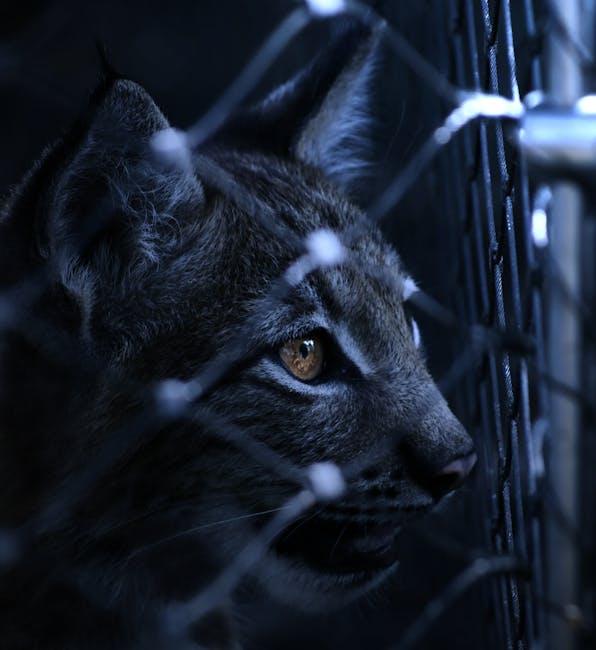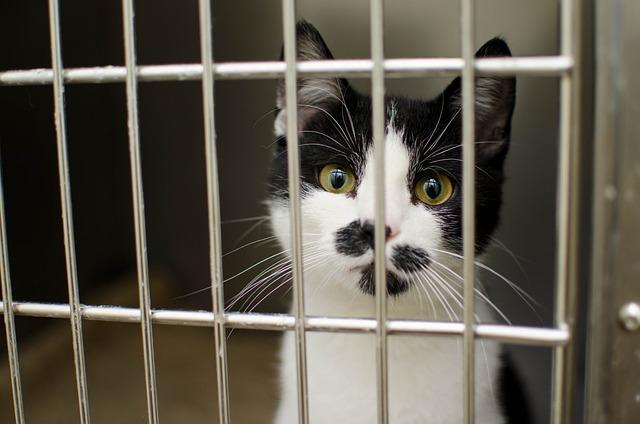Cats are creatures of curiosity and independence, often ruling their domains with an undeniable charm. Yet, there are moments when a temporary retreat to a more confined space can offer safety and comfort. My cat cage is more than just a structure; it is a sanctuary designed to meet the unique needs of our feline friends. Whether introducing a new cat to your household or ensuring your pet’s safety during travel, a well-designed cat cage offers a perfect balance between freedom and security. Through careful consideration of size, comfort, and accessibility, my cat cage transforms any space into a cozy retreat where your cat can relax and thrive. Join us as we explore the essential aspects of choosing and using my cat cage for the well-being of both you and your beloved pet.
Table of Contents
- Choosing the Perfect Cat Cage Material for Safety and Comfort
- Designing a Cozy Retreat: Essential Features of a Functional Cat Cage
- Customizing Your Cat Cage for Individual Needs and Preferences
- Tips for Maintaining Your Cat Cage to Ensure Longevity and Hygiene
- Q&A
- Closing Remarks

Choosing the Perfect Cat Cage Material for Safety and Comfort
When selecting materials for a cat cage, ensuring both safety and comfort for your feline friend is crucial. Cats are sensitive creatures with a strong preference for familiar and comfortable environments. Choosing the right material can significantly reduce stress during travel or vet visits.
Soft and Washable Fabrics are ideal for lining the interior of the cage. A cozy, warm blanket not only provides comfort but also prevents your pet from sliding around inside the cage, offering a secure and stable environment. Opt for materials that are easy to clean, as hygiene is an important factor in maintaining your cat’s health [[1]].
- Ensures easy cleaning
- Maintains warmth and comfort
- Reduces travel anxiety
Durable Plastic or Lightweight Metal structures can be excellent for the frame of your cat cage. Plastic is often used for its lightweight, durable properties, and ease of transport. On the other hand, metal frames, preferably with a softer lining inside, offer increased security and ventilation [[3]].
Ventilation and Visibility are other critical factors. Ensure the cage has multiple ventilation slots or mesh sides that promote airflow, preventing your cat from feeling overwhelmed or claustrophobic. Consider cages with clear or mesh fronts, which allow your cat to see their surroundings, providing additional reassurance.
| Material | Advantages | Considerations |
|---|---|---|
| Plastic | Lightweight, easy to clean | May lack durability over time |
| Metal | Strong, durable | Requires soft lining inside |
| Fabric Lining | Comfort, warmth | Regular washing needed |
By carefully selecting materials that meet the comfort and safety needs of your cat, you’ll ensure a more pleasant experience for both you and your furry companion during their journeys. Remember, the happier your cat feels in their cage, the smoother their travel will be.
Designing a Cozy Retreat: Essential Features of a Functional Cat Cage
Crafting a welcoming space for your feline friend isn’t just about safety—it’s about creating an environment that nurtures relaxation and happiness. To design a cat cage that’s both cozy and functional, it’s crucial to consider several features that cater to your cat’s physical and emotional needs.
First, prioritize spacious design. Just like humans, cats appreciate having enough room to stretch out and move around comfortably. Incorporating multiple levels or compartments can enhance the utility and comfort of the cage, offering your cat places to both play and unwind. Consider including features like ramps or steps to facilitate easy navigation within the space.
Ensure your kitty has access to all the essentials with ease. Integrate convenient feeding solutions, such as slide-out bowls or integrated feeders, allowing you to provide food and water without disrupting your cat’s terrain. Look for ways to streamline daily care while maintaining a tidy and organized environment.
Emphasizing comfort is key. Include soft bedding or pads to create an inviting napping nook. Choose materials that are easy to wash and maintain, contributing to a clean habitat. You might also consider adding small blankets or plush toys for that extra layer of comfort.
a truly functional cat cage can benefit from features inspired by real-world products like the Catit Cabrio carrier, which offers a 360° accessible design and integrated handle [[1]] [[3]]. These innovations can inspire aspects of your cage, ensuring it supports not only comfort but ease of use for you as the caregiver.

Customizing Your Cat Cage for Individual Needs and Preferences
Creating a personalized environment for your cat begins with a carefully designed cage that caters to its individual needs and preferences. Start by considering the layout of the cage. Cats appreciate different levels to climb and explore, so integrating multiple tiers and perch points encourages exercise and keeps them entertained. You can use sturdy shelves or suspended platforms, but ensure each is securely mounted to prevent accidents.
Comfort is key, so think about the type of resting spaces your feline friend prefers. Cats often enjoy cozy, secluded areas for napping. Consider including soft bedding or a small, enclosed space like a cat house or hammock. Providing varied textures like fleece or faux fur can add an extra touch of luxury, enhancing your cat’s rest experience and promoting a sense of security.
- Tiers and perch points for climbing
- Cozy bedding with varied textures
- Interactive toys for stimulation
Interactive elements are also crucial for keeping your cat mentally stimulated. Toys, tunnels, and scratch pads can transform the cage into a small playground. You might even integrate removable or rotating elements to keep the environment fresh and engaging. Remember to periodically introduce new toys to maintain interest and encourage curiosity.
consider any special requirements your cat might have, such as medical or dietary needs. For instance, placing food and water stations at a comfortable height can ease access for senior cats or those with mobility issues. A simple setup could look like this:
| Requirement | Solution |
|---|---|
| Mobility Issues | Low Shelves & Easy Access Stations |
| Dietary Needs | Separate Feeding Area |
| Security | Enclosed Sleeping Spaces |

Tips for Maintaining Your Cat Cage to Ensure Longevity and Hygiene
Maintaining your cat cage requires a delicate balance between sanitation and comfort. Regular cleaning is the first step in ensuring that the cage remains both inviting and hygienic. Use a pet-safe detergent and warm water to clean all surfaces thoroughly. It’s vital to focus on reaching every nook and cranny—cats can be particularly sensitive to scents and residues that are commonly overlooked. Ensure that any cleaning agents used are completely rinsed off to avoid irritation or health issues for your feline friend.
Ventilation is another critical component in cage maintenance that contributes to both the longevity of the materials and the health of your cat. Ensuring that your cat cage has proper airflow will help reduce moisture buildup, which can lead to harmful mold and mildew. If the cage is in a location with limited natural ventilation, consider using a small fan or placing the cage in a more open area. Regularly checking for any signs of rust or deterioration due to poor ventilation will also help prolong the life of the cage, maintaining a safe environment for your pet.
- Check and replace bedding frequently to maintain freshness.
- Use absorbent materials that can be easily washed and dried.
- Regularly inspect toys and accessories for cleanliness and wear.
Alongside ventilation, material upkeep is paramount. Different materials—whether metal, plastic, or wood—require unique care strategies. For metal cages, regularly inspect for rust and apply rust-resistant treatments as needed. Plastic cages should be checked for cracks or wear, which could harbor bacteria. Wooden cages need to be less exposed to direct moisture to prevent swelling and decay.
| Material | Maintenance Tip |
|---|---|
| Metal | Inspect for rust, use rust-resistant coatings. |
| Plastic | Check for cracks, ensure thorough drying. |
| Wood | Limit moisture exposure, sand rough edges. |
Remember, the well-being of your cat depends significantly on the hygiene of their space. Incorporate these practices into your regular routine to create a clean, comfortable, and long-lasting habitat. The effort you invest in maintaining the cage not only extends its life but also ensures a healthier environment for your pet.
Q&A
Q&A: Understanding the Best Cage Options for Cats
Q1: Why would I need a cage for my cat?
Answer: A cage can be useful for various reasons, including transportation, temporary confinement during travel or visits to the vet, and creating a safe space for your cat if they’re shy or anxious. It’s also beneficial for introducing new pets into your home to ensure both your current pets and the newcomer adjust safely.
Q2: What size cage is best for my cat?
Answer: The ideal cage size depends on your cat’s size and how long they’ll be using it. For short durations, a smaller cat carrier can suffice, but if your cat will spend extended time in it, such as during a long trip, a larger cage that allows for standing, stretching, and moving around is preferred. It’s essential to ensure the cage offers comfort and doesn’t restrict their movement too much. Cats often prefer spaces where they feel snug yet have room to stretch.
Q3: Can my cat give birth in a small cage or carrier?
Answer: While some cats might choose a small space to give birth due to the comfort and security it provides, it’s important to offer a larger, clean, and quiet area where your cat can feel safe. A small cage, like a compact carrier, may not provide adequate space for a mother and her kittens. Providing soft bedding and a quiet, low-traffic location will be ideal for the birthing process[2].
Q4: Is it cruel to leave my cat in a cage for too long?
Answer: Cats are natural roamers and need to explore their surroundings. Prolonged confinement in a cage can lead to stress and anxiety. It’s crucial that time in the cage is limited to necessary situations, such as travel or vet visits. Always monitor your cat’s behavior and ensure regular interactions and playtime outside of their confined space to maintain their physical and mental health.
Q5: How can I make a cage more comfortable for my cat?
Answer: Add soft bedding or a small blanket to the cage for comfort. Ensure there are no protruding sharp objects inside the cage that might harm your cat. If the cage will be used for more than temporary transport, consider placing familiar items, like a favorite toy or a piece of clothing with your scent, to reduce anxiety. Ventilation is important, so ensure airflow is adequate while keeping the cage’s interior environment cozy.
Q6: How do I introduce my cat to the cage?
Answer: Introduce the cage gradually to your cat by placing treats or toys inside and allowing them to explore it at their pace. Don’t force your cat inside, as this can create negative associations. Positive reinforcement through treats and praise will help them feel more comfortable. You can start with short durations of confinement, slowly increasing as they become more at ease with the space.
By understanding your cat’s needs and preferences, you can ensure their time in a cage is safe, comfortable, and stress-free.
Closing Remarks
finding the right setup for your cat’s cage can make a significant difference in both your pet’s comfort and your daily routine. Whether you’re focusing on easy-to-clean flooring options or selecting accessories that enhance your cat’s living space, every choice contributes to a healthier, happier environment for your feline friend. Remember, a well-thought-out cat cage not only caters to your pet’s needs but also minimizes maintenance efforts on your part, allowing you to spend more quality time enjoying each other’s company. For further tips on improving your cat’s cage setup, refer to our suggested resources and expert recommendations. Happy cat-caring!







0 Comments